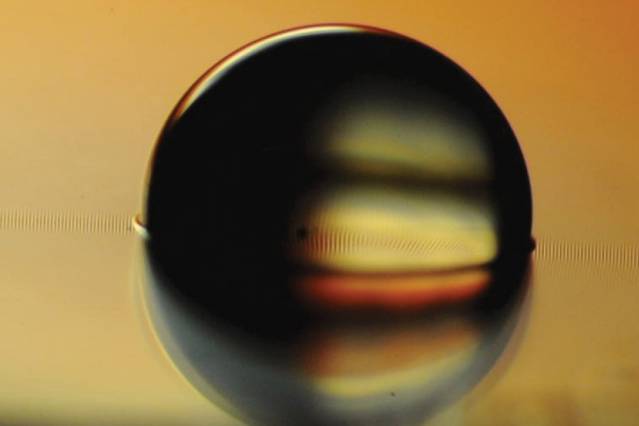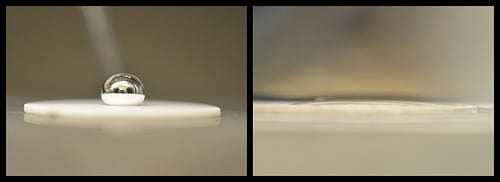
Image courtesy of the researchers
Researchers develop treated surfaces that can actively control how fluids or particles move.
Researchers at MIT and in Saudi Arabia have developed a new way of making surfaces that can actively control how fluids or particles move across them. The work might enable new kinds of biomedical or microfluidic devices, or solar panels that could automatically clean themselves of dust and grit.
“Most surfaces are passive,” says Kripa Varanasi, an associate professor of mechanical engineering at MIT, and senior author of a paper describing the new system in the journalApplied Physics Letters. “They rely on gravity, or other forces, to move fluids or particles.”
Watch a water droplet get pulled across an “active” surface designed by MIT researchers.
Video: Melanie Gonick/MIT
Varanasi’s team decided to use external fields, such as magnetic fields, to make surfaces active, exerting precise control over the behavior of particles or droplets moving over them.
The system makes use of a microtextured surface, with bumps or ridges just a few micrometers across, that is then impregnated with a fluid that can be manipulated — for example, an oil infused with tiny magnetic particles, or ferrofluid, which can be pushed and pulled by applying a magnetic field to the surface. When droplets of water or tiny particles are placed on the surface, a thin coating of the fluid covers them, forming a magnetic cloak.
The thin magnetized cloak can then actually pull the droplet or particle along as the layer itself is drawn magnetically across the surface. Tiny ferromagnetic particles, approximately 10 nanometers in diameter, in the ferrofluid could allow precision control when it’s needed — such as in a microfluidic device used to test biological or chemical samples by mixing them with a variety of reagents. Unlike the fixed channels of conventional microfluidics, such surfaces could have “virtual” channels that could be reconfigured at will.
While other researchers have developed systems that use magnetism to move particles or fluids, these require the material being moved to be magnetic, and very strong magnetic fields to move them around. The new system, which produces a superslippery surface that lets fluids and particles slide around with virtually no friction, needs much less force to move these materials. “This allows us to attain high velocities with small applied forces,” says MIT graduate student Karim Khalil, the paper’s lead author.
The new approach, he says, could be useful for a range of applications: For example, solar panels and the mirrors used in solar-concentrating systems can quickly lose a significant percentage of their efficiency when dust, moisture, or other materials accumulate on their surfaces. But if coated with such an active surface material, a brief magnetic pulse could be used to sweep the material away.
Read more . . .
The Latest on: Droplet-based microfluidic platforms
[google_news title=”” keyword=”Droplet-based microfluidic platforms” num_posts=”10″ blurb_length=”0″ show_thumb=”left”]
via Google News
The Latest on: Droplet-based microfluidic platforms
- Smartphone Trading: The Rise of App-Based Investment Platformson April 7, 2024 at 5:00 pm
With high-speed internet becoming increasingly accessible, app-based trading platforms began to emerge, offering a level of convenience and accessibility that was previously unheard of.
- C-CAMP develops new OptiDrop platform to study single cellson April 4, 2024 at 7:30 am
The novel microfluidic chip-based platform allows for optical sensing ... photomultiplier tubes and a pulse counter. As each droplet flows through the microfluidic channel lit by an incident ...
- C-CAMP develops new affordable platform to study single cellson April 2, 2024 at 2:02 pm
“Traditional flow cytometers, used for fluorophore-based ... platform using a proprietary microfluidic chip with integrated optical fibres, photomultiplier tubes, and a pulse counter. As each ...
- Novel platform harnesses microfluidics and optics for rapid, low-cost cellular analysison April 1, 2024 at 5:00 pm
The platform readily distinguished between beads based on both their physical dimensions and ... By overcoming the cost and complexity barriers that have hindered the adoption of droplet microfluidics ...
- New single-cell analysis tech incorporates advanced fiber optics directly into microfluidic chipson March 31, 2024 at 5:00 pm
Preksha Gupta, lead researcher on the project, said, "The OptiDrop platform marries the flexibility of flow cytometry with droplet microfluidics' power, offering scalable optical sensing solutions ...
- Droplet Microfluidics in PCR: Technology and Applicationson March 26, 2024 at 4:00 am
Digital Droplet PCR (ddPCR) is a method for performing digital PCR use microfluidic water-oil emulsion technology. By utilizing microfluidics and fractionating DNA samples into nanoliter droplets , ...
- Researchers develop affordable, user-friendly method for single-cell reactions at the nanoliter levelon March 22, 2024 at 10:03 am
Current methods for constructing a nanoliter reactor for whole-genome multiple displacement amplification from single cells primarily rely on microvalve-based microfluidic devices, microwells ...
- Spaceship-like disc detects colon cancer with sound-driven droplet vibrationon March 15, 2024 at 10:56 am
That is why it is not surprising that the news about a new platform caused ... to enable new diagnostics based on exosomes. As explained beyond that, the droplet begins leaning and runs the ...
- Microfluidic Platforms for Performing Surface-based Clinical Assayson March 3, 2024 at 4:00 pm
[28] These examples represent the variety of important analytes that can be investigated using wall-based assays in microfluidic devices, the multitude of detection methods, and the assortment of ...
- Droplet generation in microfluidicson August 30, 2022 at 8:18 am
Droplet-based microfluidic systems have already entered laboratories, and currently, it is possible to create (monodisperse) droplets that range in size from femto to nanoliters. Therefore ...
via Bing News









